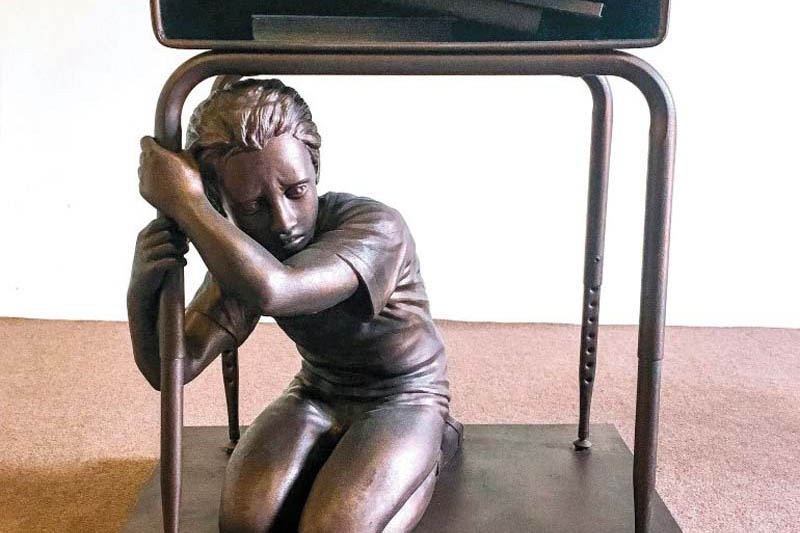
Powerful images that depict disturbing events in ways that literature alone cannot can be illuminating and healing. Following are three descriptions of different media that capture recent man-made disasters, still very close to the surface for many of us.
The first, Please Stand By, is an example of cartoon art in the aftermath of 9/11. The second, The Last Lockdown, is about a sculpture created after the mass school shooting in Parkland, FL. Both illustrate the fear-inducing paralysis of traumatic events. The last, Memorial Rock Garden, describes bereaved children painting stones to memorialize their deceased dads.
Please Stand By
In the immediate aftermath of the September 11, 2001, terrorist attack on America, several artists joined together to produce a soft cover book titled 9/11: Artists Respond. It is a collection of art, sequenced to showcase the artists’ response to the terror that befell the world.
One nine-frame piece entitled “Please Stand By…,” by Jeph Loeb and J. Scott Campbell, features a girl of about 8 years old watching cartoons on television. By the third and fourth frames, the image on the screen changes to a live feed of the Twin Towers ablaze.
As the little girl stands transfixed, stuffed animal in hand and her face less than 12 inches from the screen, the commentator announces, “We interrupt this program to take you live…”
The little girl turns away and cries out, “Mommy!” The next three frames begin with her mother dropping a basket of laundry. Then, with her face contorted in anguish, she embraces her daughter to shield her from the unrelenting televised images.
The final frame is a close up of the little girl asking, “Mommy, when are the cartoons gonna come back on?”
The Last Lockdown
The next image is a haunting statue, as described by journalist Josh Hafner, of a “small girl cowering beneath an open school desk, clutching a leg as she gazes into the distance with a look of fear in her eyes.”
The sculpture was created by Manuel Oliver, an artist who lost his 17-year-old son Joaquin in the Parkland, FL, mass shooting earlier this year.
As Oliver said, “It’s too late for us to save Joaquin from gun violence, but through art, my family and I are making sure that we protect the rest of the kids out there.”
“Talking about the trauma is rarely if ever enough,” advises noted trauma expert Bessel van der Kolk. He points to the Holocaust Memorial in Jerusalem and the Vietnam War Memorial in Washington, D.C., “as good examples of symbols that enable survivors to mourn the dead and establish the historical and cultural meaning of the traumatic events to remind survivors of the ongoing potential for communality and sharing.”
Memorial Rock Garden
In 2002 at North Shore Child & Family Guidance Center, a group of boys and girls who lost fathers in the attack on the World Trade Center decorated stones to be placed in a memorial rock garden.
The kids in the bereavement group sat together around a table covered with newspaper. In front of each of them was a large smooth oval-shaped stone. They decorated the stones with unique designs of paint and glitter, each one a personal remembrance of their fathers.
“Mine is painted gold,” beamed Mack. “I painted it gold because my dad is like gold to me.”
A heart framed Jenny’s design, “because my dad will always be in my heart.”
On Seth’s stone were two intertwined hands, a small one and a larger one that showed “me and my dad were best friends.”
Victoria painted a fire hat and said, “My dad is my hero.”
We might do well to remember that when funding cuts threaten to decimate arts programs in schools there is more at stake then we might imagine. The impact of the arts is not measured by standardized tests and its value is incalculable.
Andrew Malekoff is the Executive Director of North Shore Child & Family Guidance Center, which provides comprehensive mental health services for children from birth through 24 and their families. To find out more, visit www.northshorechildguidance.org.
































